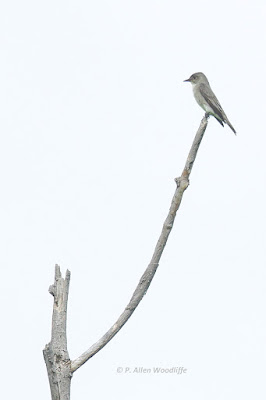One of the earliest ones to show up is the Serviceberry (Amelanchier spp). They typically bloom in early May, and in fact are in full fruit right now. The berries are juicy and quite tasty.
Also in early May is Pawpaw (Asimina triloba). The flowers actually start to open before the leaves are very far along. It is a rare shrub in southwestern Ontario, confined to some of the best quality woodlots on rich, well-developed soil.
Canada Redbud (Cercis canadensis) is probably the rarest woody plant in Canada. It is known as a legitimate native species due to a record from Pelee Island way back in the early 1900s. It is gone now, and there are no known naturally occurring individuals anywhere in the country. The species is popular as an ornamental in residential areas across southwestern Ontario. The striking pinkish-red flowers are distinctive especially since they are in prime condition before the leaves develop.
The female flowers are considerably less obvious.
Some relatively rare plants include Rough-leaved Dogwood (Cornus drummondii).
A very rare tree, which is legally endangered due to being limited primarily to the sand plain of Norfolk County, is this next one: Cucumber Magnolia (Magnolia acuminata).
A much more common member of the same family as the Cucumber Magnolia, and arguably the flagship species of the Carolinian Life Zone (CLZ) is Tuliptree (Liriodendron tulipifera).
Another very rare tree of the CLZ is Kentucky Coffee-tree (Gymnocladus dioicus). Its natural occurrences are very limited, but there are some propagation efforts taking place and I have seen it planted in various places such as municipal parks, etc. This type of propagation is not the best way to ensure the species survives, as it these sites are largely ornamental settings and will never become a functioning ecosystem. But at least there is some public education potential and it is better than having the species become extirpated entirely from Ontario.
On some of the sandy shorelines of the Lake Erie, especially places like Rondeau, Point Pelee and Pelee Island, one can find reasonably healthy populations of this next species: Common Hop-tree (Ptelea trifoliata), although it is anything but 'common'. In fact it is legally a Threatened species in Ontario and Canada.
Another endangered tree is Red Mulberry (Morus rubra). It too is largely limited in Canada to Rondeau, Point Pelee and Fish Point on Pelee Island. These next two photos show the female flowers, which will develop into a deep red berry very popular with birds.
Much more common are these next few species.
 |
| Fragrant Sumac (Rhus aromatica) |
 |
| Choke Cherry (Prunus virginiana) |
 |
| Winter Berry (Ilex verticillata) |
While I was busy photographing parts of trees for a tree identification project, I had to look for flowers of as many species as possible. I must admit that over the years I had noticed the male flowers of the various oak trees, but I had never given much thought to what the female flowers looked like. When I eventually found them, I had to use the full extent of my macro equipment!
This next photo shows the male flowers of a White Oak (Quercus alba). They are quite obvious, but not quite the size of the developing leaves.
Here are the flowers of a Chinquapin Oak (Quercus muhlenbergii), barely the width of the leaf stem.....
.....and the similarly sized flowers of Black Oak (Quercus velutina), almost concealed at the base of a leaf stem.
Just think, each mighty oak tree you see, had its humble beginnings developing as an acorn in a tiny flower smaller than an eraser on the end of a pencil!























































